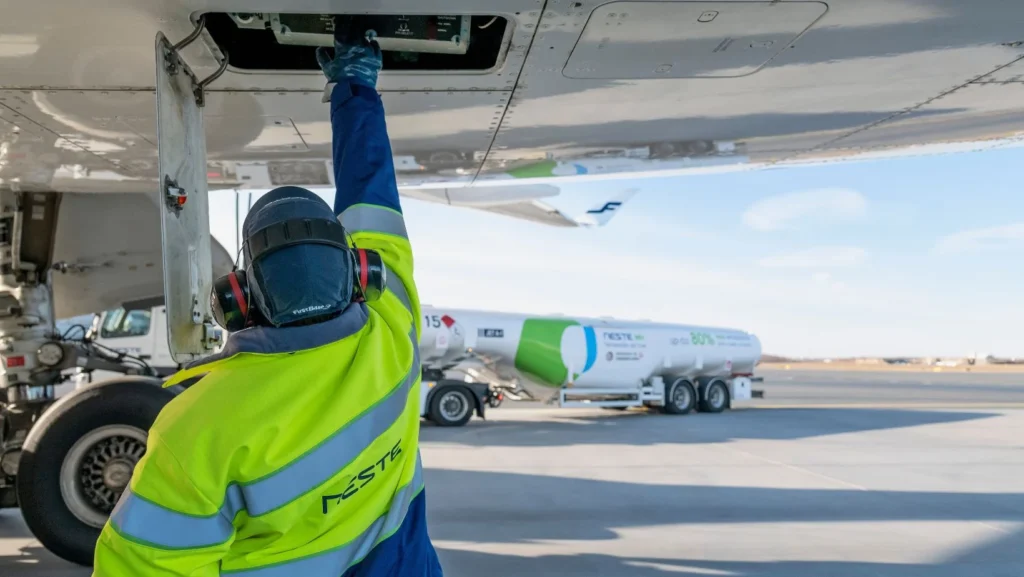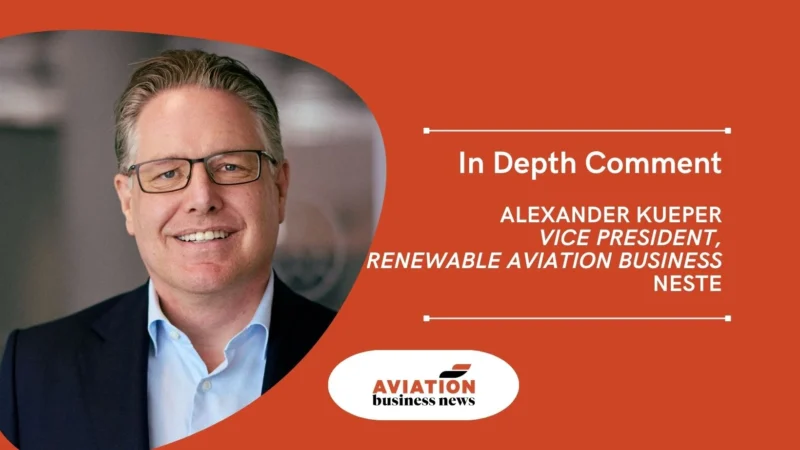Alexander Kueper, vice president of renewable aviation business at Neste explores some of the key drivers that can help the ramp up of SAF production and encourage usage.
The aviation industry’s carbon emissions goals cannot be reached without substantial scaling of sustainable aviation fuel (SAF) production.
Recent projections from the International Air Transport Association (IATA) shows that SAF production is poised to reach 1.9 billion litres (1.5 million tonnes), which would account for 0.53% of aviation’s fuel need in 2024 – still far from what is needed to reach the industry’s net-zero emissions goal by 2050.
As the largest SAF producer, Neste began producing SAF in 2011 and today provides SAF to many major airports and is used by many major airlines.
Support from the regulatory side
Higher cost is often regarded as the largest barrier to SAF adoption today. Compared with regular fossil jet fuel, SAF is often two to three times more expensive, making it a challenge for airlines operating in a highly competitive market to adopt. Over time, factors such as maturing technology and increasing supply might be able to narrow the cost gap. However, in the near term, supportive policy is crucial to create a level playing field and gain industry momentum.
For SAF producers, long-term, stable incentive programmes like the RFS in the US or Canada’s Clean Fuel Regulation, which mirrors US state-level Low Carbon Fuel Standard programmes, are generally preferable to shorter-term, and more limited tax credits. The SAF Blenders Tax Credit (BTC) in the Inflation Reduction Act is a positive development that recognises the role SAF will play in decarbonising aviation.
Outside of California, an increasing number of states are also considering policy frameworks that support the use of SAF. In July 2023, the State of Illinois enacted the SAF purchase tax credit, enabling airlines to earn $1.50 purchase credit per whole gallon of SAF purchased for use in Illinois.
Following this supportive policy framework, in July 2024, Neste announced the supply of up to one million gallons of SAF to United Airlines for its use at Chicago O’Hare International Airport, enabling the airline to be the first to purchase SAF for operational use at the airport and making air travel in Illinois more sustainable.
SAF adoption in Europe is also expected to accelerate on the heels of the RefuelEU Aviation Regulation, which is part of the EU’s Fit for 55 package. The programme requires fuel suppliers to deliver minimum volumes of SAF as part of the total volume of jet fuel supplied. This starts with a mandate of 2% SAF in 2025 and increases to 6% in 2030 and 70% SAF in 2050.
Collaboration with industry partners
One of SAF’s greatest advantages is that it’s a ‘drop-in’ solution, meaning that it can be used in existing engines and fuel infrastructure, opening up the world’s vast existing energy infrastructure, such as pipelines, storage tanks or terminals that carry fossil products to be easily used for SAF – making airlines or business aviation companies have easier access to this lower-carbon fuel. This is what Neste has been doing.
This article continues after the below picture…

In 2022, Neste’s SAF was delivered to New York’s LaGuardia Airport through the Colonial and Buckeye pipeline systems – two essential pieces of American energy infrastructure.
In 2023, Neste commissioned terminal capacity at Vopak’s Los Angeles terminal in California for storing SAF. This partnership further expanded the availability of Neste’s renewable fuels in the Southern California region.
Furthermore, fast-forward to 2024, Neste commissioned terminal capacity at ONEOK’s terminal in Houston, Texas, for blending and storing SAF. This is a major step in further expanding the availability of Neste’s SAF to airlines also operating from airports east of the Rocky Mountains all the way to the East Coast.
It is also key to get access to the airport fuel infrastructure to be able to service airlines who want to use SAF across their operations. It is not always easy to get access but examples show that it works – using the new integrated supply chain into Singapore Changi Airport, Neste delivered its first locally produced SAF to Singapore Airlines quickly followed by a similar delivery at the airport to Emirates. Collaboration with energy industry partners is an essential part of making SAF more widely available.
Commitment to sustainability demonstrated by airlines and business aviation
In addition to support on the regulation side, SAF adoption is also driven by other parties in the aviation industry, including airlines and big corporations.
Neste supplies SAF to many major airlines and business aviation users around the world. These entities are demonstrating their commitment to sustainability by including SAF in their energy solutions portfolio, which will not only help to ramp-up SAF production but also to generate more public awareness of the benefits related to SAF. Together, these groups are painting a future where SAF becomes a preferred solution for all travellers who’d like to enjoy flying but with a smaller carbon footprint.
Right now, SAF can be blended at up to 50% with traditional jet fuel, but different pilot programmes of using 100% SAF to fuel different types of planes have been conducted in both Europe and the US. There is a near future where SAF can be used in its neat form, which will significantly help the aviation industry reduce emissions further.
Keep ramping up SAF production
Currently, Neste has a global production capability of more than one million tonnes per annum.
Neste is expanding its SAF production capacity to 1.5 million tonnes of SAF (515 million gallons) in 2024 and to 2.2 million tonnes (750 million gallons) in 2026.
Waste and residue materials, such as used cooking oil, are still the main raw materials for today’s SAF production. Though the availability of waste and residues are sufficient to ramp up SAF production in the near term, Neste is also excited to see the potential of tapping a new generation of raw materials and is engaged in developing such new pathways including algae, lignocellulosic, or even power to liquid. These technologies hold the potential of replacing all of the fossil jet fuel with SAF.
